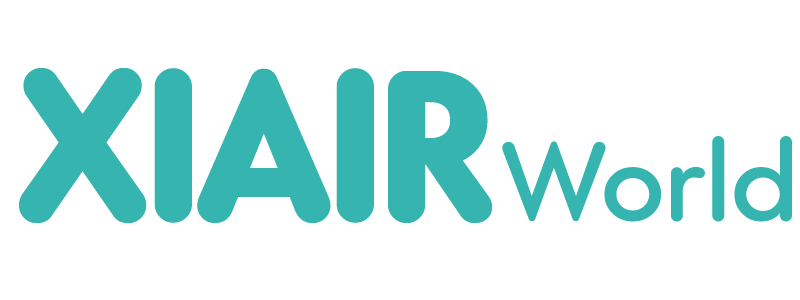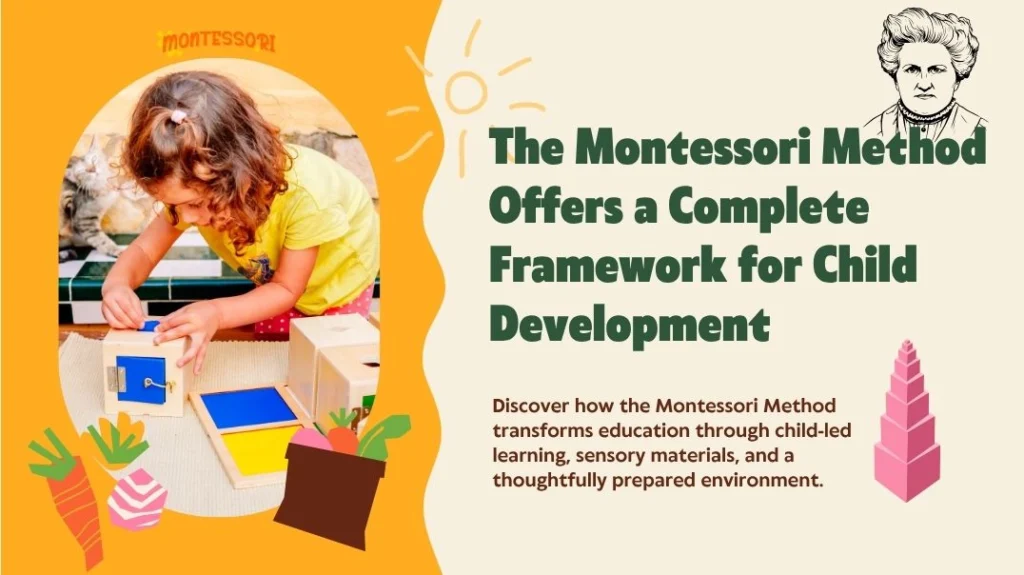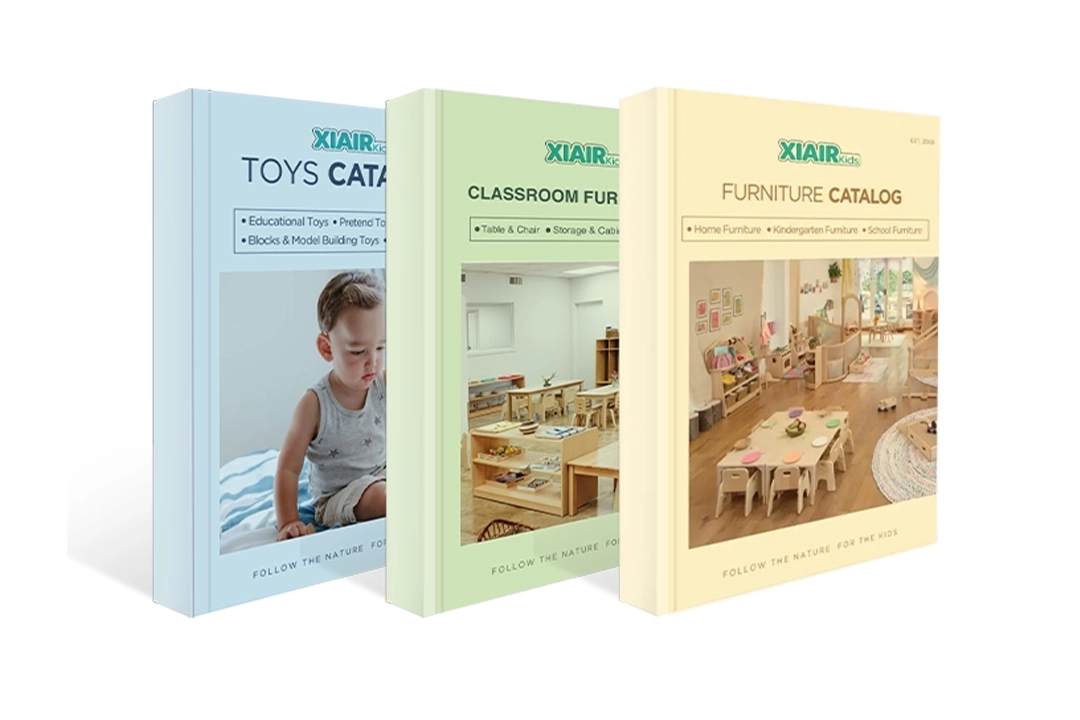Finding an education model that fits how children grow is harder than it should be. Parents see their kids lose focus, lose interest, and lose confidence. Teachers are overwhelmed with rigid systems and limited flexibility. Meanwhile, every child learns differently—some faster, some slower, some hands-on, some visually—and most traditional classrooms don’t keep up.
The result? Children who feel unseen and educators who feel stuck. Learning becomes a routine instead of a discovery. Children are boxed into grades, ages, and expectations that rarely reflect who they really are. The learning environment becomes something to get through, not grow in.
That’s where the Montessori Method changes everything. With its child-centered structure, hands-on materials, and flexible classroom design, the Montessori Method isn’t just another curriculum—it’s a complete framework for developmental learning. Whether you’re setting up a school, teaching at home, or redesigning your classroom, the Montessori Method gives you a way to teach that finally works the way children work.
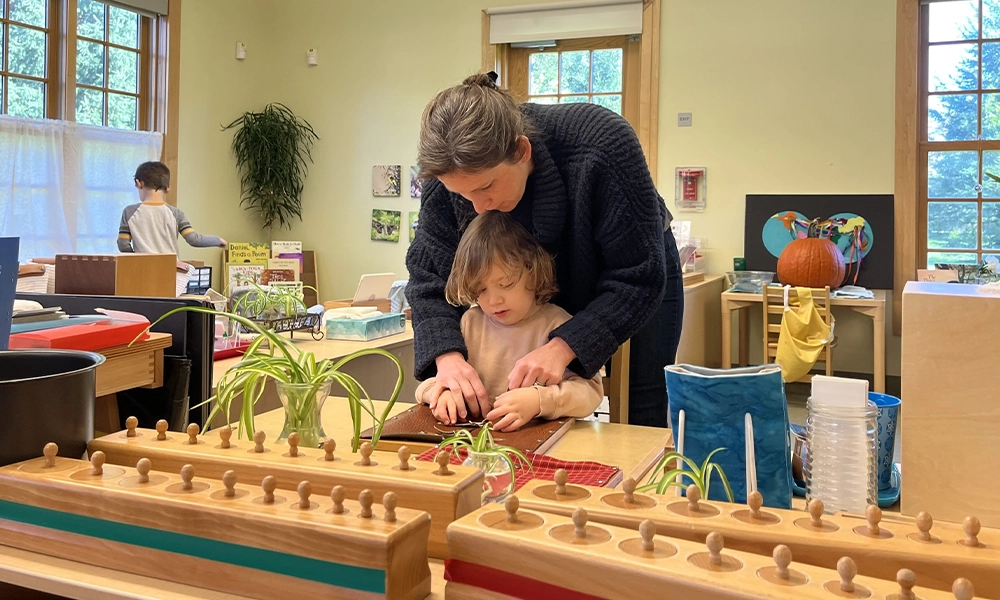
Introduction
The Montessori Method is a globally recognized educational approach that centers learning around the child, not the system. Created by Italian physician and educator Maria Montessori in the early 20th century, this method has shaped how generations of children develop cognitively, emotionally, and socially.
At its core, the Montessori Method is built on trust in a child’s natural ability to learn. It emphasizes independence, hands-on learning, and carefully prepared environments where children can explore freely at their own pace. Teachers act as guides rather than instructors, and learning becomes a process of discovery, not memorization.
This approach doesn’t just impact test scores—it changes how children think, solve problems, and interact with the world. It’s a method that aligns deeply with how the brain develops, how curiosity is nurtured, and how confidence is built.
In this article, we’ll break down the principles, practices, and lasting impact of the Montessori Method and explore how it can be implemented effectively in classrooms, homes, and entire school systems.
Maria Montessori & the Montessori Method – Education Transformed
Maria Montessori was not a traditional educator. She began her professional life as a physician—the first woman in Italy to earn a medical degree in 1896. Her scientific background shaped her view of education as a process grounded in observation, experimentation, and respect for natural development.
It was during her work with children labeled as “uneducable” that she noticed something revolutionary: when given the right materials and environment, these children could learn independently and joyfully. This discovery was the seed of what would later become the Montessori Method.
Rather than designing a top-down system focused on instruction, Montessori built a method around the child. She observed that children learn best when they are free to choose, move, and engage with hands-on activities in a thoughtfully prepared space. The Montessori Method emerged as a response to this discovery—a way to unlock the full potential of every child, regardless of background or ability.
Her first classroom, the Casa dei Bambini (Children’s House), opened in Rome in 1907. It introduced concepts that would later define Montessori classrooms worldwide: child-sized furniture, open shelves with learning materials, and freedom within boundaries. These elements were not just aesthetic choices—they were expressions of Montessori’s core belief that the environment should serve the child.
Montessori’s ideas quickly spread beyond Italy, influencing educators across Europe and North America. As the Montessori Method gained international attention, it was adopted in public and private schools, community centers, and even in home environments.
From Observation to Global Movement
What makes the Montessori Method unique is its foundation in careful observation and a deep respect for the natural stages of child development. Montessori didn’t impose a theory; she uncovered one through real-world practice.
Today, over a century later, her method continues to evolve while remaining true to its origins. It’s used in more than 140 countries, proving that this child-centered approach is not bound by culture, geography, or time. In a world where education often feels rigid and test-driven, the Montessori Method offers something profoundly different: a way to educate that empowers children and respects how they naturally learn.

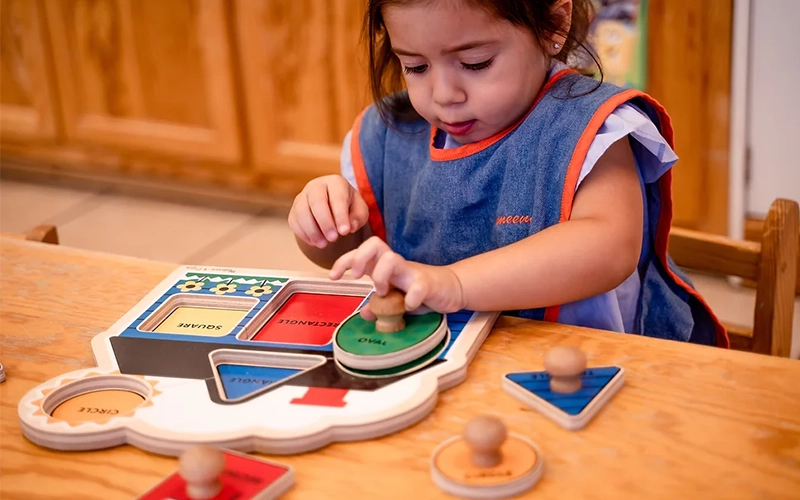
What Is the Montessori Method? A Clear Definition and Philosophy
The Montessori Method is a child-centered educational approach that views learning as a natural, self-driven process. Rather than focusing on rigid instruction or standardized testing, this method encourages children to explore, question, and discover at their own pace. It’s a model built on trust—trust in the child’s ability to lead their development when placed in the right environment.
At its core, the Montessori Method rests on the idea that education should align with the natural phases of growth. Maria Montessori believed that children are naturally curious and capable, and that educators should act as facilitators rather than authorities.
Core Features of the Montessori Method
- Self-Directed Learning
In a Montessori setting, children choose their activities from a set of developmentally appropriate options. This freedom builds confidence, decision-making skills, and internal motivation.
- Prepared Environment
The classroom is designed to support independence and movement. Materials are organized on accessible shelves, and the space is calm, orderly, and inviting. Every element serves a purpose.
- Concrete to Abstract Progression
Children begin learning through physical manipulation of materials—touching, moving, and experimenting. Over time, these experiences form the foundation for abstract thinking and problem-solving.
- Multi-Age Classrooms
Rather than grouping children by a single age, Montessori classrooms span 2–3 years. Younger children learn from older ones, and older students reinforce their knowledge by teaching.
- Intrinsic Motivation Over External Rewards
There are no gold stars or grades. Instead, children develop a love for learning by experiencing the joy of mastery and purposeful work.
Philosophical Foundations That Set It Apart
The Montessori Method is not just about how children learn—it’s about how they grow. Its principles are grounded in a deep respect for each child’s unique timeline and style of development. Montessori called this approach an “aid to life,” not simply education.
Unlike traditional methods that treat education as input and output, the Montessori philosophy sees the child as an active builder of their mind. Learning happens through movement, repetition, and real-world experience, not passive listening.
By focusing on the whole child—cognitive, emotional, physical, and social—the Montessori Method prepares kids not just for school, but for life.
Five Core Principles Behind Success: Why Montessori Works
The success of the Montessori Method lies in its ability to align educational practice with the way children naturally develop. Rather than impose structure from the top down, this approach builds learning environments around the needs, tendencies, and abilities of the child. At the heart of the Montessori Method are five foundational principles that shape everything from classroom setup to daily routines.
These core principles are not abstract theories—they’re observable, practical, and time-tested across cultures and age groups. Let’s explore them one by one.
1. Respect for the Child
The Montessori Method begins with the idea that children deserve the same respect as adults. Respect in this context means more than polite behavior; it means honoring the child’s need for autonomy, their capacity for choice, and their inner drive to learn.
In a Montessori classroom, this respect is reflected in every interaction. Teachers don’t interrupt a child who is concentrating. Children are not forced to conform to a one-size-fits-all schedule. Instead, they’re given space and time to grow at their own pace, and their voice is part of the learning process.
2. The Absorbent Mind
Maria Montessori observed that children between birth and age six possess what she called an “absorbent mind.” This means they naturally take in information from their surroundings without conscious effort, much like a sponge.
The Montessori Method leverages this powerful mental state by offering a rich, sensory environment filled with language, order, movement, and culture. Materials are designed to appeal to the senses and to support exploration. Because of the absorbent mind, even complex ideas like math, language, and geography can be introduced at a surprisingly young age, without stress or memorization.
3. Sensitive Periods
During specific windows of time, children become especially receptive to learning particular skills. These are known as “sensitive periods.” For example, a child might suddenly show a strong interest in letters, pouring, or social interactions.
The Montessori Method doesn’t ignore these periods—it responds to them intentionally. A Montessori guide observes each child closely and introduces materials or lessons that match their current interest. This ensures that learning feels natural and satisfying rather than forced or frustrating.
4. The Prepared Environment
A hallmark of the Montessori Method is the emphasis on the environment as an active part of the learning process. Montessori classrooms are carefully designed spaces where everything has a purpose and a place.
Furniture is child-sized. Shelves are open and materials are arranged in sequence. Lighting, color, noise, and even plant life are all chosen to support focus and calm. The environment gives the child freedom within limits—it invites exploration, but also teaches order, responsibility, and self-regulation.
In many ways, the prepared environment is the “third teacher” in Montessori, alongside the adult and the child.
5. Auto-Education (Self-Education)
Perhaps the most revolutionary aspect of the Montessori Method is its belief that children are capable of educating themselves. Given the right materials, the right environment, and respectful guidance, children naturally seek out knowledge.
Auto-education doesn’t mean children learn alone—it means the learning comes from within. This principle empowers learners to build independence, resilience, and a lifelong love of discovery.
It also changes the role of the adult. Rather than acting as the authority who delivers knowledge, the Montessori guide becomes an observer, a facilitator, and a designer of learning opportunities.
These five principles form the philosophical and practical backbone of the Montessori Method. They are not just ideas—they are actions, habits, and strategies that show up in every aspect of Montessori learning. They explain why this method remains relevant more than a century after its creation—and why it continues to transform classrooms and learners around the world.

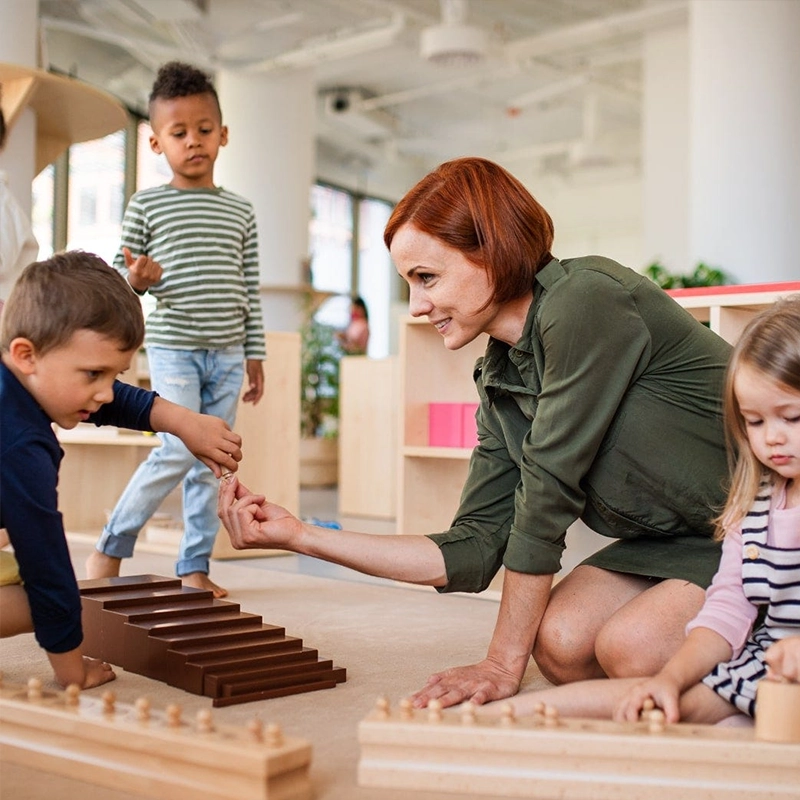
Montessori Classroom Design: The Prepared Environment in Action
One of the most potent elements of the Montessori Method is the idea that the environment is not just a backdrop for learning—it’s an active participant. In a well-designed Montessori classroom, everything serves a purpose, and every detail is intentional. This is what Maria Montessori called the prepared environment.
When children enter a Montessori space, they should feel calm, curious, and confident. The physical layout supports freedom of movement, independent exploration, and social interaction—all within an ordered, beautiful, and functional setting.
To explore a full breakdown of how to build an authentic Montessori classroom, read our dedicated guide on Montessori Classroom Design.
Key Features of a Prepared Montessori Environment
Child-Sized and Accessible
In a Montessori classroom, the furniture is built for the child, not simply smaller versions of adult pieces, but thoughtfully proportioned to support independence and comfort. When children can sit down by themselves, reach shelves without help, and move materials freely, they feel more confident and capable.
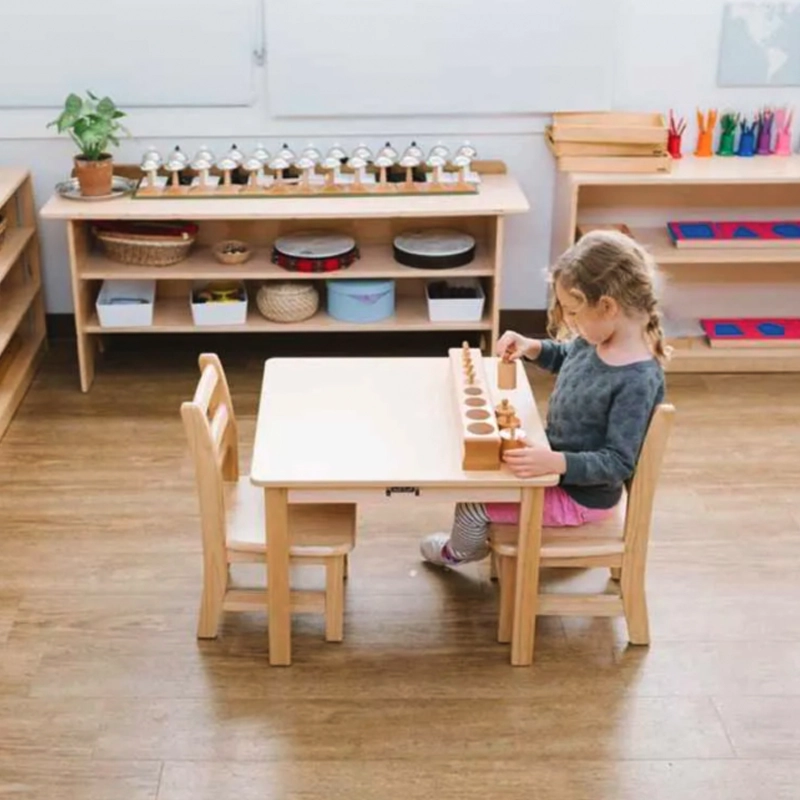
Recommended products:
- Open tray organizers for individual work materials
- Solid wood child-sized tables and chairs (for ages 3–6 and 6–12)
- Height-appropriate shelving with rounded corners
Defined Learning Zones
Each area of the classroom serves a developmental function. Practical life, sensorial, mathematics, language, and cultural activities are separated to reduce cognitive overload and help children focus. These zones are not marked with signage, but with spatial cues and material placement.
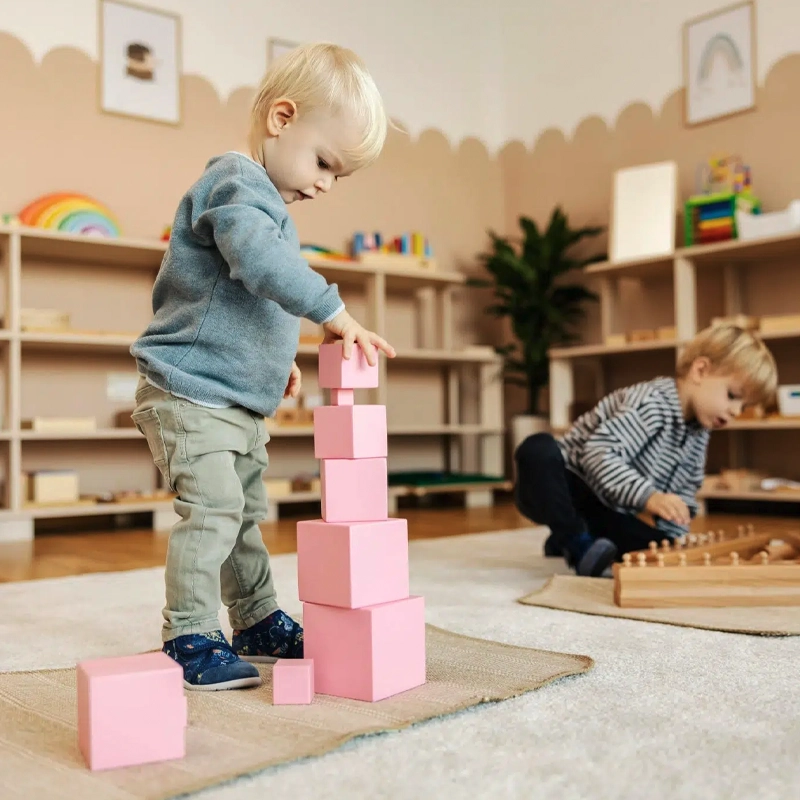
Recommended products:
- Material-specific furniture (e.g., handwashing stands, bead cabinets, movable alphabet drawers)
- Modular shelving units to divide learning areas
- Work mats or rugs to visually define floor workspaces
Minimal and Purposeful Design
Montessori classrooms are calm, ordered, and intentional. Materials are displayed attractively but not decoratively—every object is meant to be touched, explored, and used. There is no clutter or overstimulation.
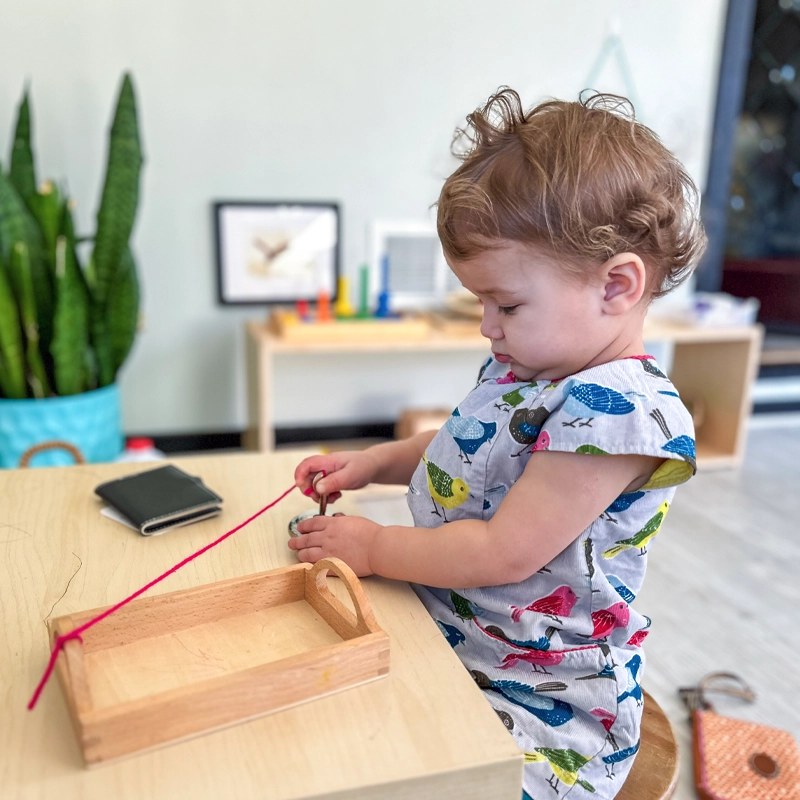
Recommended products:
- Practical life tools: ceramic pitchers, wooden trays, real utensils
- Natural finish furniture (birch, beech, maple)
- Display easels for child-created artwork
Freedom Within Structure
The room invites children to explore, but not at random. The physical layout channels movement and encourages responsibility. Everything has a place, and every place has a reason.
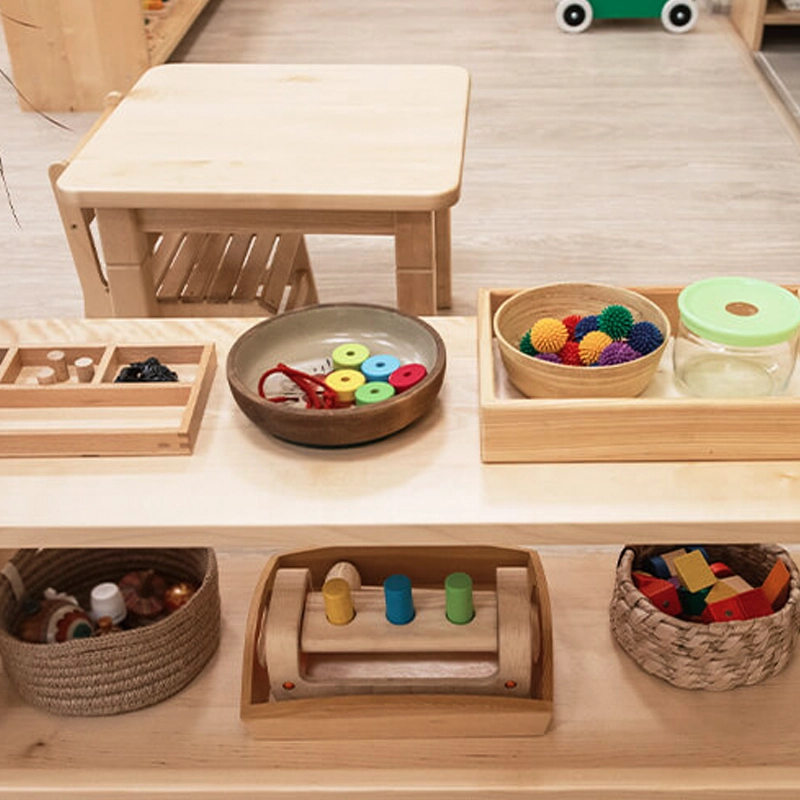
Recommended products:
- Open display units arranged by subject, difficulty, and order of use
- Storage baskets and trays with clearly designated spaces
- Custom shelves that match the sequence of Montessori materials
How Design Reinforces Montessori Principles
The prepared environment is a physical expression of the Montessori principles discussed earlier, especially respect, independence, and freedom within limits.
- Respect for the child is seen in how materials are placed at their level.
- Independence is nurtured through accessible tools and open spaces.
- Self-education is enabled by the logical sequence of materials and the clarity of layout.
By allowing children to act freely within a thoughtfully structured space, the Montessori Method gives them absolute control over their learning experience. This empowerment builds confidence, focus, and joy in learning—qualities that are difficult to cultivate in traditional classrooms.
Product Application: Creating a Montessori Classroom with Purpose
Whether you’re opening a school or transforming a single room at home, designing a prepared Montessori environment requires more than aesthetic choices—it requires intentionality.
That’s where our custom-designed Montessori furniture and classroom solutions come in. We offer child-sized tables, open shelving units, work rugs, and curated material sets that align precisely with Montessori Method principles. Every piece is designed to be durable, developmentally appropriate, and adaptable to multi-age settings.
Building a prepared environment doesn’t have to be overwhelming. With the right tools, it becomes an opportunity to shape a space where children thrive naturally and where Montessori education comes alive in every corner.
Don’t just dream it, design it! Let’s chat about your custom furniture needs!
Hands-On Learning: Sensorial Materials, Language & Math Tools
One of the most defining features of the Montessori Method is its emphasis on tactile, hands-on learning. Montessori classrooms are filled with carefully crafted materials that children manipulate directly, allowing them to internalize abstract concepts through physical experience.
These materials aren’t toys—they are tools for discovery. Each one is designed with a clear educational purpose and introduces one concept at a time. Their structure, texture, and progression are rooted in Montessori’s deep understanding of how children build knowledge from the concrete to the abstract.
Let’s explore how the Montessori Method brings learning to life through sensorial, language, and math materials—and how the right tools can elevate every child’s learning journey.
Sensorial Materials: Sharpening Perception Through Touch and Order
Sensorial work is foundational in Montessori education. These materials refine a child’s ability to see, hear, touch, taste, and smell the world with greater clarity. They also help children categorize and compare attributes such as size, color, weight, texture, and temperature.
Examples of key sensorial materials:
- Pink Tower – develops visual discrimination of size and spatial awareness
- Knobbed Cylinders – train fine motor control and differentiation of dimensions
- Color Tablets – enhance color recognition and gradation matching
- Sound Boxes – sharpen auditory perception and memory
- Rough and Smooth Boards – build tactile sensitivity and vocabulary
Recommended products:
- Complete sensorial material kits for ages 3–6
- Color-coded storage shelves for sensorial sequences
- Classroom display stands to organize and present tactile materials
Explore more in our complete guide on Montessori Sensorial Materials
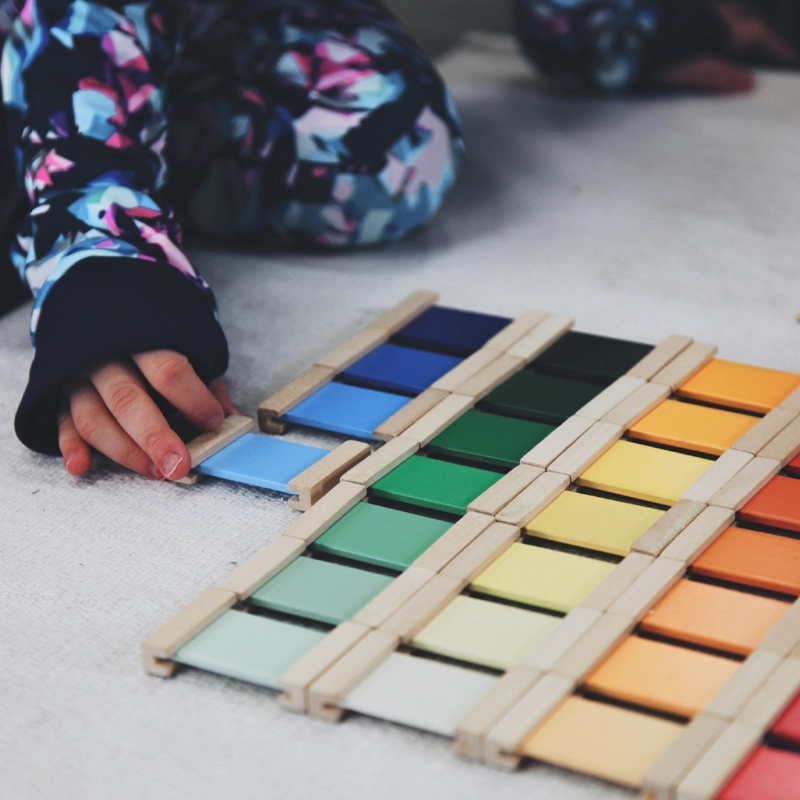
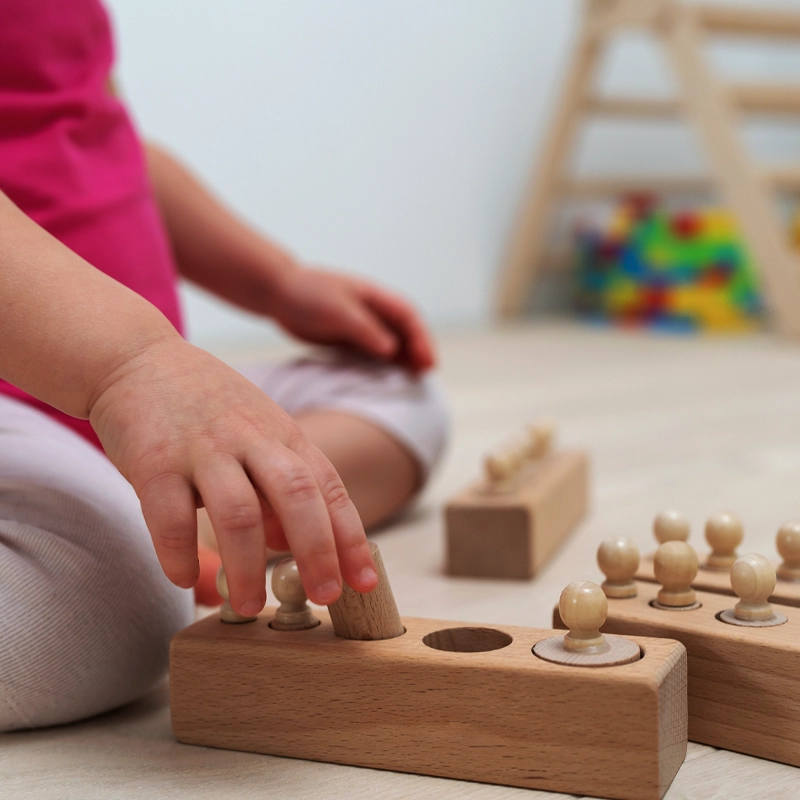
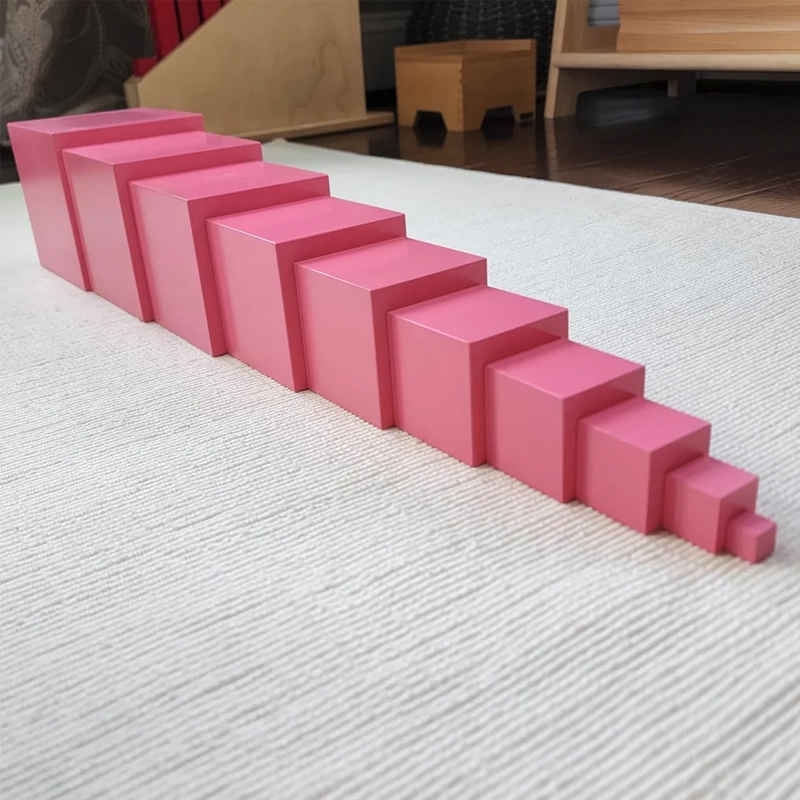
Language Materials: Building Literacy from Sound to Symbol
The Montessori Method approaches language as a developmental journey—from spoken words to phonetic awareness to reading and writing. Children learn not by memorizing letters, but by feeling them, hearing their sounds, and using them to construct meaning.
Core language tools include:
- Sandpaper Letters – children trace letters with their fingers while learning associated sounds
- Moveable Alphabet – allows children to build words phonetically before they can write
- Metal Insets – develop pencil grip, shape control, and preparation for writing
- Language Object Sets – for sound-object matching and vocabulary expansion
Recommended products:
- Language learning material sets (3–6, 6–9 age groups)
- Durable movable alphabet trays with upper and lowercase letters
- Sandpaper letter boards in cursive or print formats
- Metal inset display stations and fine-motor control worksheets
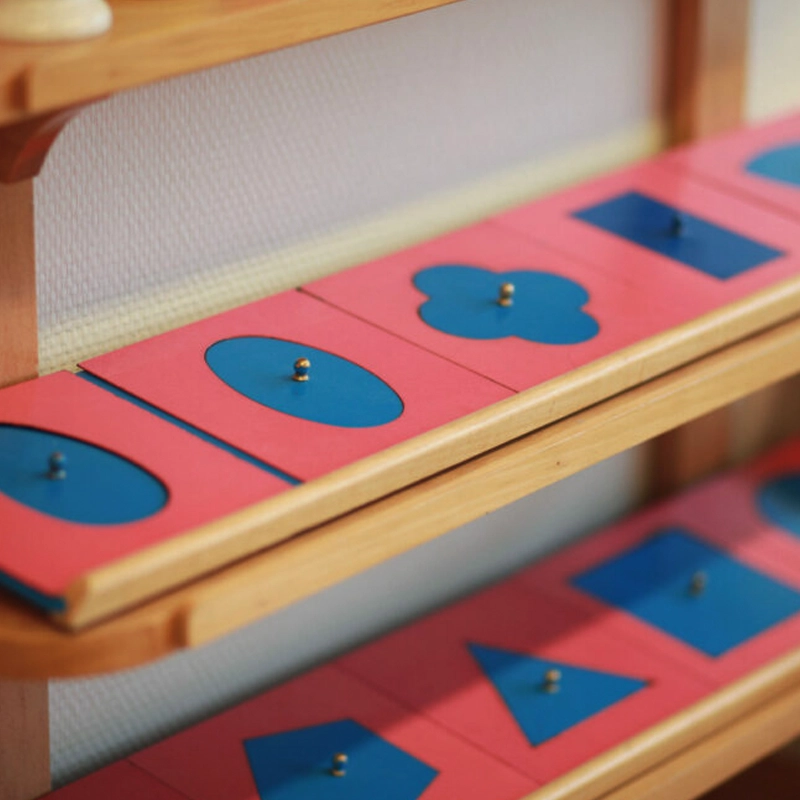
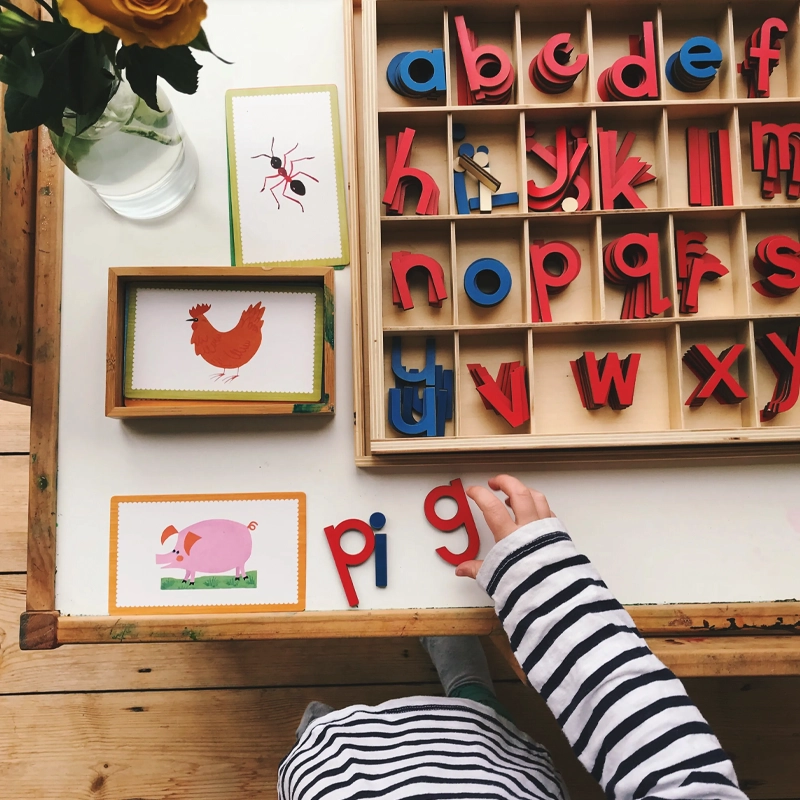
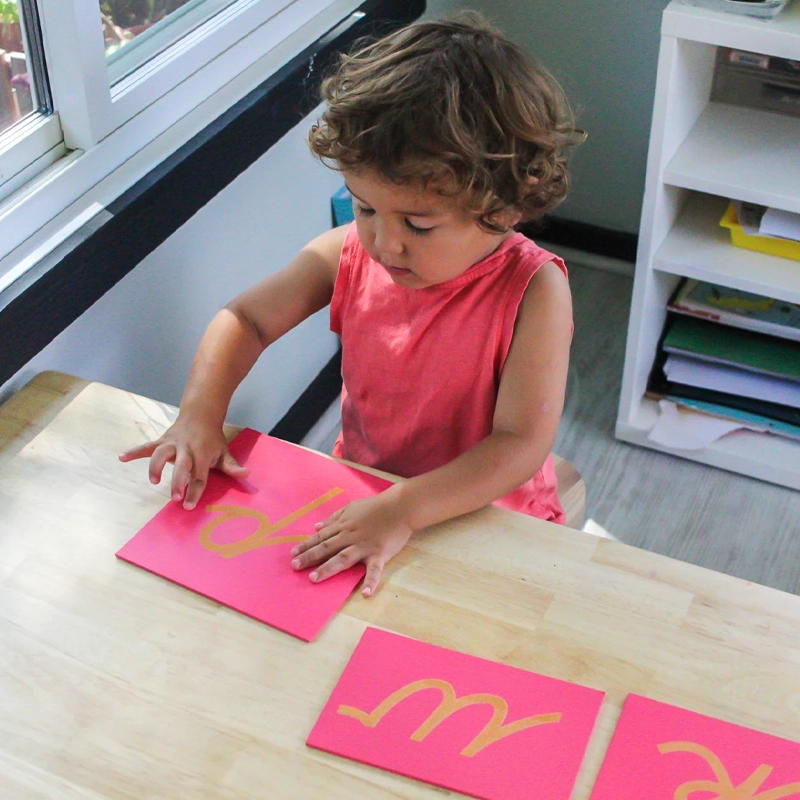
Mathematics Materials: Making Numbers Tangible and Logical
Math in the Montessori Method is hands-on from the start. Children first develop an understanding of quantity and number through physical manipulation. Abstract symbols and operations are introduced only after the concept has been internalized through touch and movement.
Essential Montessori math materials:
- Number Rods – teach counting, size sequencing, and the concept of quantity
- Golden Beads – introduce the decimal system and operations (addition, subtraction, etc.)
- Stamp Game – makes place value and calculations more visual
- Bead Chains – help children understand skip counting, multiplication, and squaring
- Fraction Insets – introduce parts of a whole and basic geometry
Recommended products:
- Full math materials kit with progression map (ages 3–12)
- Bead cabinet systems for golden beads and bead stairs
- Montessori decimal materials with color-coded trays
- Classroom math stations customized by learning level
For a complete progression of number work, visit our Montessori Math Materials
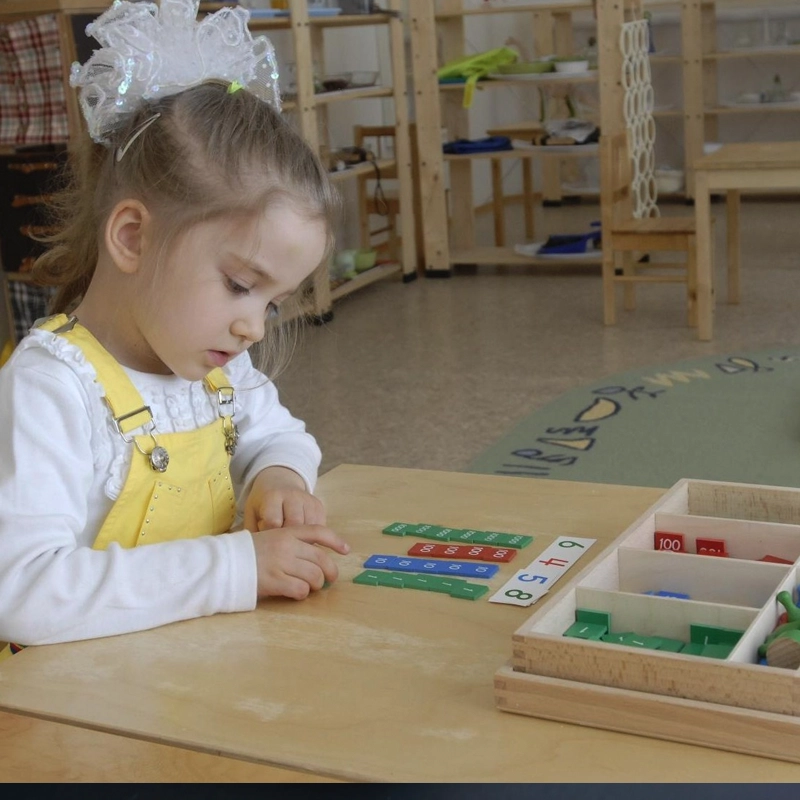

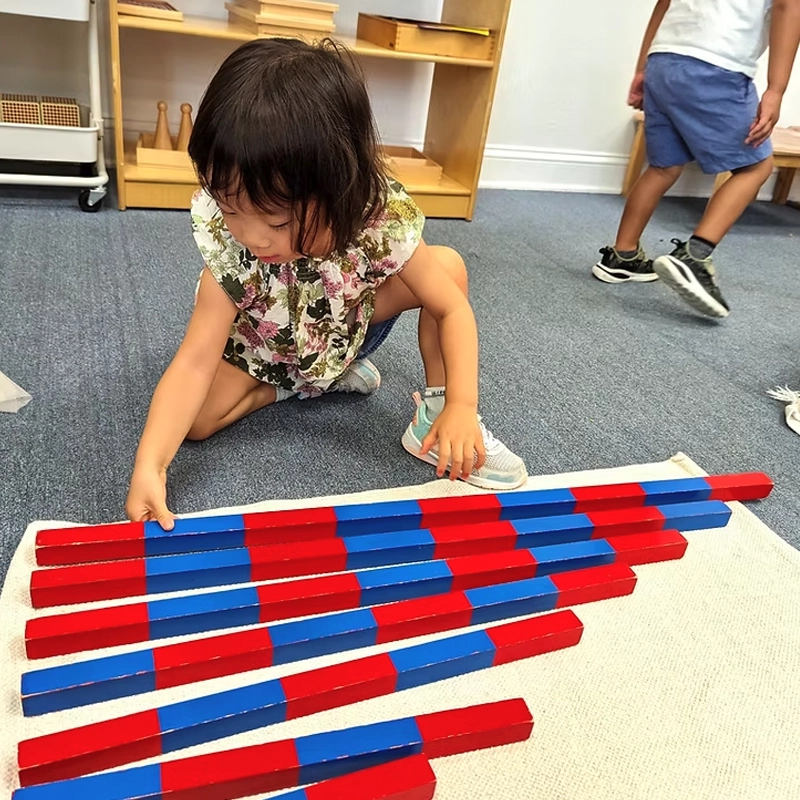
From Material to Mastery: Why Quality Tools Matter
Montessori materials are only effective when they are durable, accurately designed, and developmentally aligned. Cheap replicas or incomplete sets disrupt the learning sequence and reduce a child’s ability to self-correct or explore independently.
We provide a curated line of sensorial, language, and math tools that follow Montessori’s original design standards. Our materials are made from child-safe wood, color-coded for clarity, and organized in shelf-ready formats.
Whether you’re outfitting a new classroom or upgrading existing materials, we can help you build a complete and authentic hands-on learning environment, grounded in the proven success of the Montessori Method.
Support Beyond Academics: Practical Life and Inclusive Learning
Practical Life Materials: Foundation for Independence
In the Montessori Method, Practical Life activities form the essential starting point of education. They develop independence, motor coordination, concentration, and a sense of responsibility in children—skills that extend far beyond academics.
Educational Objectives
- Promote mastery of daily self-care routines like dressing, eating, and tidying.
- Establish order and executive function through sequential task completion
- Prepare the hands for writing through repetitive fine motor movements
Recommended Materials & Classroom Design
| Material Type | Purpose | Setup Suggestions |
|---|---|---|
| Pouring Sets (ceramic/glass) | Enhances hand-eye coordination | Use on anti-slip trays, with easy-to-reach shelving |
| Cleaning Kits (broom, mop, cloth) | Instills responsibility and routine | Hang tools at child height with wall-mounted organizers |
| Dressing Frames (buttons, zippers) | Refines fine motor skills | Display on tiered open shelving for self-selection |
| Child-Safe Kitchen Tools | Introduces food prep and hygiene | Integrate with food area, using color-coded containers |
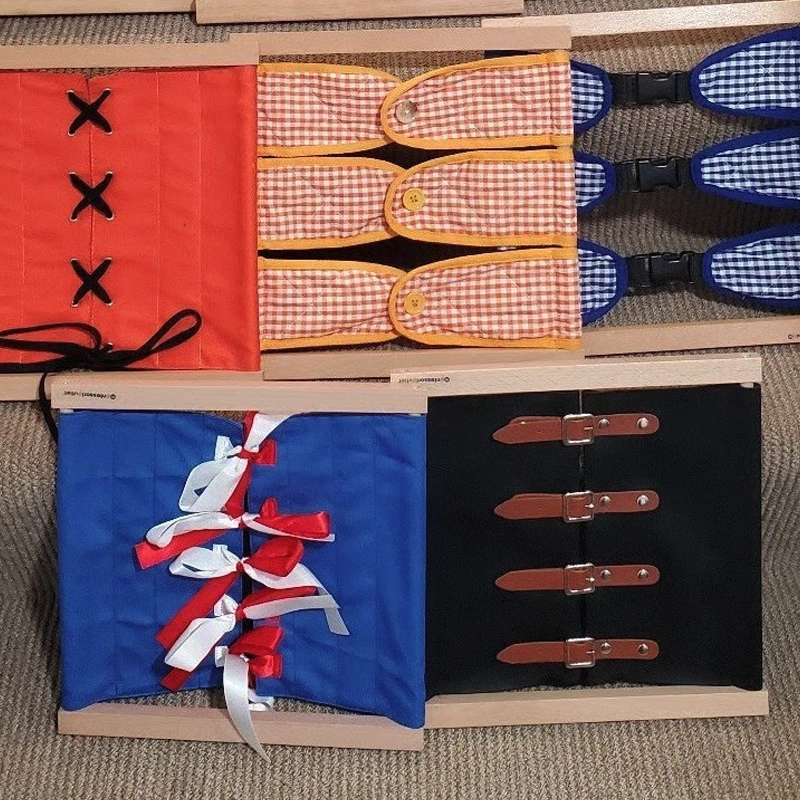
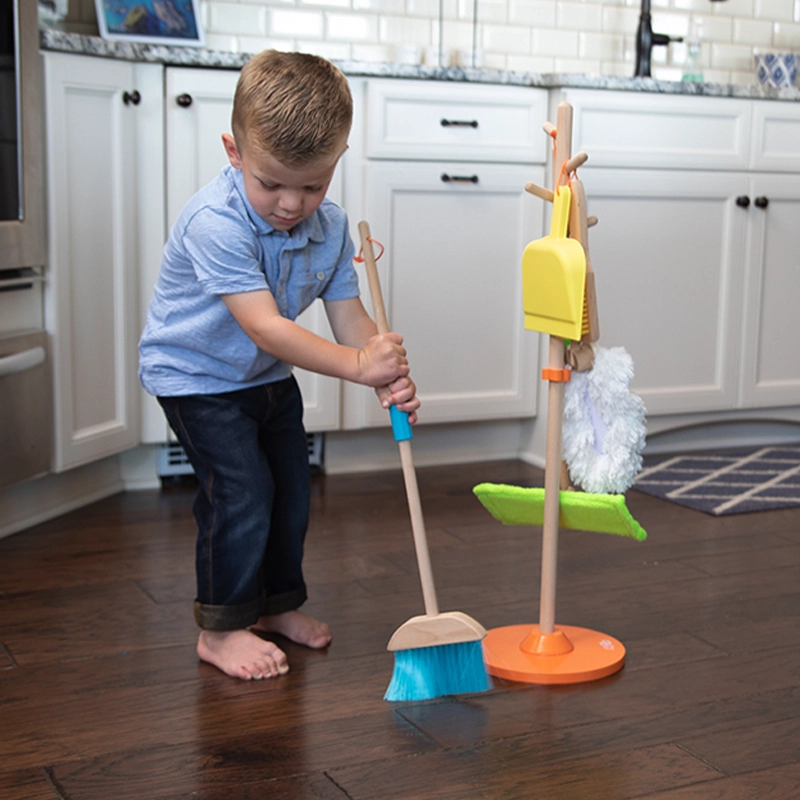
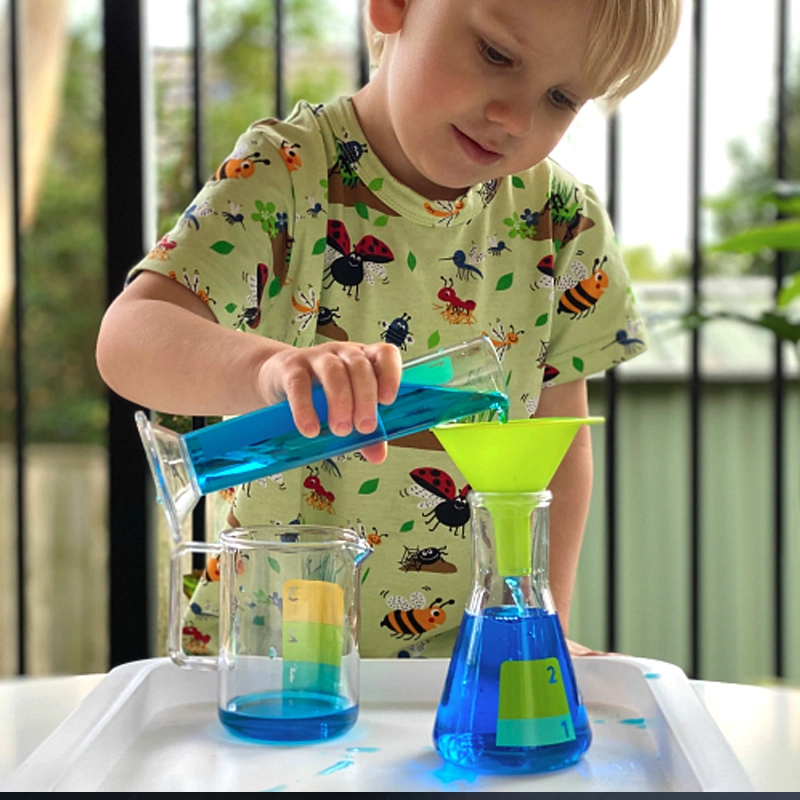
Implementation Tips
- Rotate tasks weekly to sustain interest and skill variation
- Ensure children can complete each task independently from start to finish
- Avoid plastic imitations—use fundamental, scaled-down tools that convey respect and purpose
Explore a complete breakdown of materials and strategies in our guide on Montessori Practical Life Materials.
Inclusive Learning: Meeting Diverse Developmental Needs
The Montessori Method offers a uniquely adaptable framework for supporting neurodiverse learners, including children with autism, ADHD, or sensory processing differences. Its focus on self-paced, hands-on engagement makes it naturally inclusive.
Instructional Principles
- Accommodate varying energy levels, attention spans, and sensory thresholds
- Reduce behavioral triggers through consistent environments
- Offer tools for emotional regulation and task repetition
Suggested Materials
- Visual task boards with pictorial sequences for non-verbal learners
- Weighted lap pads or seat cushions for grounding and body awareness
- Duplicate workstations to support repetitive practice
- Portable quiet zones with noise-reducing furniture or fabric dividers
Design Strategies
- Incorporate a “Neurodiversity Corner” for individualized learning
- Use muted colors and non-reflective surfaces to avoid overstimulation
- Regularly observe and adjust based on behavioral patterns
Cultural Materials: Connecting Children to the World
Cultural learning in the Montessori Method is not a supplemental activity—it’s a central means of building global awareness, scientific curiosity, and historical understanding.
Learning Objectives
- Foster respect for diversity through geography, biology, and the arts
- Support thematic exploration across multiple disciplines
- Encourage storytelling, map work, and comparative analysis
Essential Cultural Materials
| Material Type | Skill Area | Recommended Tools |
|---|---|---|
| Puzzle Maps | Geography & Spatial Awareness | Continent maps, landform boards, country outlines |
| Three-Part Classification Cards | Biology, Botany, Zoology | Animal groups, plant families, food chain diagrams |
| Music Bells and Rhythm Sets | Arts & Auditory Skills | Color-coded bells, tempo cards, cultural instruments |
| History & Culture Timelines | Chronological Thinking | Color-coded bells, tempo cards, and cultural instruments |
Setup Guidelines
- Display materials thematically, rotating monthly based on the curriculum
- Use low-friction shelves and visual organization to promote independence
- Encourage children to create connections between different cultural domains (e.g., music + geography)
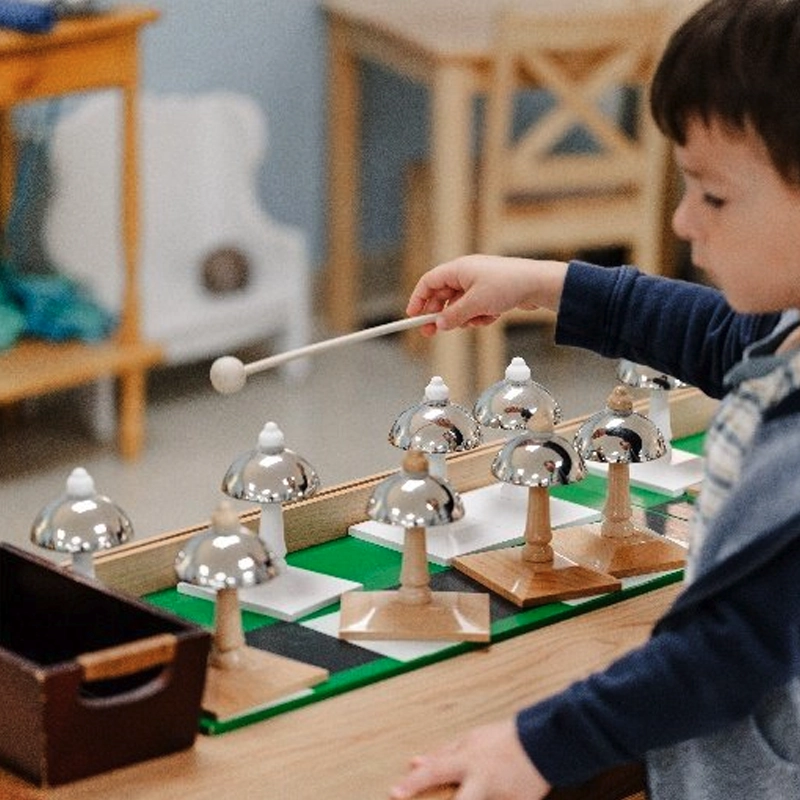
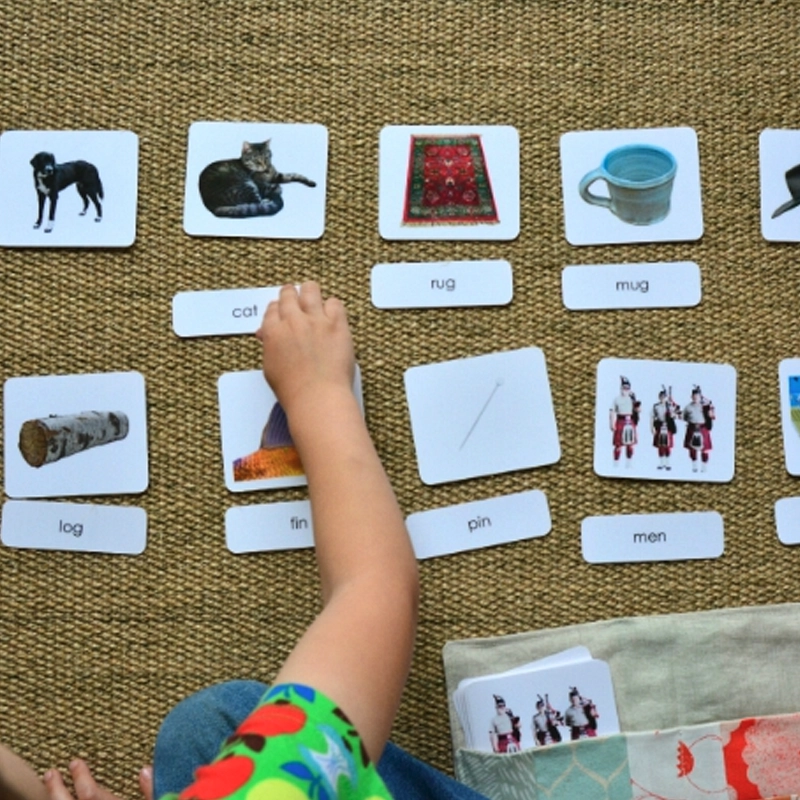
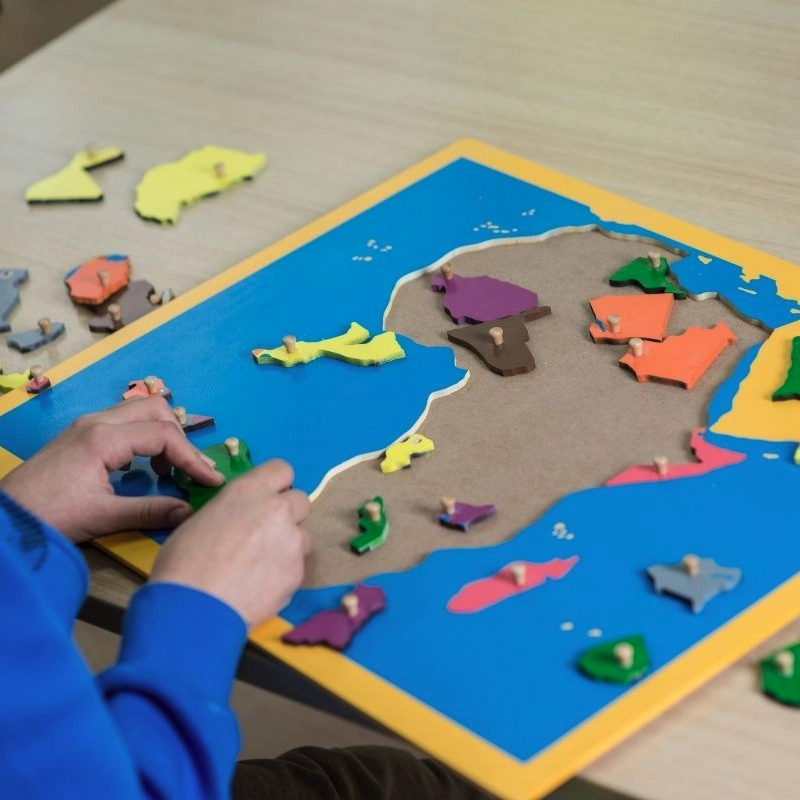
Educator’s Role: Observation, Guidance & Teacher Tools
In the Montessori Method, the teacher is no longer a traditional instructor but a carefully trained In the Montessori Method, the adult in the classroom is not a lecturer, but a silent guide—a keen observer, environmental designer, and calm anchor. This role is foundational to the method’s success. Montessori called the adult the “Third Component of the Prepared Environment.”
Designing the Learning Atmosphere: Teachers as Environment Architects
Montessori guides are responsible for preparing the classroom daily, ensuring that every element supports independence, exploration, and concentration. Unlike traditional settings where teachers control the pacing and content, Montessori educators curate spaces where the environment teaches.
Essential Tools for the Educator’s Setup
- Low storage carts with lockable drawers for rotating materials and lesson organization
- Demonstration trays: clean, neutral-toned, segmented trays for presenting new concepts
- Adjustable lighting and display boards for highlighting featured materials
- Montessori observation chairs: light, movable seating for teachers to remain mobile and discreet
These items help the adult maintain classroom flow without drawing unnecessary attention, preserving the autonomy of learners while subtly guiding progress.
Observation as the Educator’s Primary Method
Observation is not passive in the Montessori Method—it is a practiced skill. Montessori teachers use it to gather data on student interests, sensitivities, readiness, and social dynamics.
Observation Tools That Matter
- Daily observation logs (digital or clipboard-based) to track work cycles
- Color-coded activity counters to monitor material usage frequency
- Small pegboards or activity charts to display student choices (without public ranking)
- Audio-dampened planning corners for quiet review and lesson planning during the work cycle
These tools empower teachers to adjust the environment instead of constantly redirecting behavior, shifting responsibility from enforcement to facilitation.
Guiding Without Directing: When to Step In
Montessori educators practice strategic non-intervention. They only interrupt when a child:
- Repeatedly misuses materials
- Disrupts the concentration of others
- Seeks help beyond their reach
The aim is to allow self-correction. Therefore, materials are designed to reveal errors without adult input.
Teacher Training That Honors the Method
Authentic Montessori classrooms require educators trained not only in pedagogy but in emotional neutrality, material mastery, and spatial management.
Professional Development Essentials
- Material training kits with lesson sequences and handling guidance
- Classroom management modules focused on silence, tone, and movement
- Peer observation models: allowing guides to visit each other’s classrooms
- Furniture-use guides: showing how shelves, chairs, and mats are placed intentionally
Schools can support training by offering branded storage systems, mobile demo carts, and customizable shelving units as part of the onboarding process.
Montessori for All Children: Embracing Neurodiversity, Autism, and ADHD
Montessori education is not a method that tolerates difference—it is a system that is fundamentally designed to honor it. At the heart of the Montessori Method lies a profound belief in the uniqueness of each child’s developmental journey. This makes it one of the most neurologically attuned and developmentally inclusive educational frameworks available today.
Human Tendencies and the Universal Child
Maria Montessori believed that all children, regardless of ability, are guided by universal tendencies—such as the need to explore, to order, to orient, and to repeat. For children with autism or ADHD, these tendencies may express themselves differently, but they are no less present or powerful.
In traditional systems, divergence is seen as disruption. In Montessori environments, it is seen as variation within a natural pattern, not a deviation from it.
The Prepared Environment as a Regulator of the Nervous System
Montessori classrooms are intentionally designed as sensory-integrated ecosystems. For neurodivergent learners, such environments are not just beneficial—they are essential. Montessori’s structured, calm, visual clarity, and self-directed pacing offer direct support for children whose brains process input differently.
Key Elements That Support Regulation:
- Material isolation: Only one variable per activity reduces cognitive overload
- Order and predictability: Materials are always in the same place, in sequence
- Freedom with boundaries: Children choose work, but within a curated framework
- Spatial neutrality: Furniture, light, and shelves follow a consistent, soothing rhythm
These aren’t incidental features—they are deliberate supports for the executive function challenges common in ADHD and the sensory processing sensitivities common in autism.
Our furniture lines support these goals with low-open shelving, neutral-toned work rugs, and child-height furniture that respects autonomy.
Montessori’s Developmental Logic and the Child with Autism
Children on the autism spectrum often experience the world with heightened intensity and deep focus. Montessori’s materials invite intense focus, without interruption. Repetition is not discouraged, but embraced.
The Absorbent Mind, a core Montessori concept, is especially resonant: neurodiverse children absorb their environment with profound sensitivity. Thus, every detail of the classroom becomes instructional in tone, texture, rhythm, and space.
Tools like structured sequencing trays, task completion cards, and pictorial steps help scaffold abstract tasks into manageable, logical parts.
Montessori and ADHD: Agency as Intervention
Children with ADHD often struggle in settings where movement is punished and control is externalized. Montessori flips this: the child is expected to move, to choose, and to direct their learning.
This cultivates internal regulation, the very executive capacity often targeted in ADHD interventions. Moreover, embedded routines—from rolling mats to replacing materials—build procedural memory and foster attention.
Lightweight classroom organizers, task journals, and choice boards help maintain flow while reinforcing order.
Guides, Not Correctors: Adults in Neurodiverse Classrooms
Montessori adults observe rather than command. This is not passive—it’s precise. In neurodiverse settings, the adult becomes a therapeutic observer, adjusting the environment before changing the child.
Training for such guides should include:
- Understanding of developmental neuropsychology
- Practical experience with multi-sensory differentiation
- Skill in using classroom space and material progression as primary tools, not verbal correction
Our Montessori Inclusion Toolkit includes not only material adaptations but also educator protocols and observation templates for neurodiverse learners.
A System That Trusts the Child
In a Montessori classroom, the child with autism is not trained to conform—they are invited to unfold. The child with ADHD is not subdued—they are empowered to lead their rhythm. This is not a classroom that adapts—it is a classroom that was already designed for diversity.
Montessori is not merely inclusive. It is inherently inclusive. It is not a workaround for neurodiversity—it is a response to the human condition.
Why Choose the Montessori Method: Practical Impacts for Educators and Learning Spaces
Choosing the Montessori Method isn’t just about adopting a different curriculum—it’s about reimagining the very architecture of education. For educators and school leaders, it translates into measurable differences in classroom flow, teacher engagement, and student outcomes. Here’s how this method transforms learning environments in tangible, transformative ways.
1. Work Cycles: Cultivating Deep Focus and Flow
Montessori classrooms operate on 2–3 hour uninterrupted work cycles. This structure allows children to enter deeper levels of concentration, move fluidly between subject areas, and engage in self-determined progression.
Impact on Learning Spaces:
- Needs material rotation systems to refresh interest and challenge students
- Requires mobile demo stations to introduce new materials efficiently
- Demands classroom maps or schedules for student reference
Product Solutions:
- Modular shelving units on casters for easy material rotation
- Heavy-duty demonstration tables with locking wheels
- Magnetic visual schedule boards that support independence
2. Choice Within a Framework: The Right Balance
Montessori supports children making genuine choices, but choices are always guided. Learning spaces must reflect this balance: being safe and structured, yet free enough for self-direction.
Space Implications:
- Materials are visible but not overwhelming
- Precise boundaries for each work area
- Zones for quiet work, small groups, and movement
Product Solutions:
- Low dividers that visually demarcate areas without visual disruption
- Transparent bins and trays that display contents clearly
- Rug sets sized for individual and group zones, marking personal workspace
3. The Flow of the Adult: From Instructor to Operator
In Montessori, teachers don’t shift between desks and boards—they move deliberately, acting as environment operators rather than lecturers. This flow is supported by intentional design.
Operational Requirements:
- Adults need discreet transport stations for lesson materials
- A unified layout that allows seamless movement without crowding
- Observation-support tools that can be used without interrupting lessons
Product Solutions:
- Teachers push carts with lockable bins for lesson transitions
- Observation stations with clipboards and seating built into shelves
- Portable demonstration trays that function as miniature teacher desks
4. Rich, Rotating Materials = Constant Engagement
One hallmark of a successful Montessori room is a shelf that seems to refresh daily. Teachers must introduce, rotate, and retire materials to maintain engagement and match developmental progression.
Implementation Strategies:
- Keep an inventory map to track material placements
- Prepare backup kits for simultaneous use
- Align material displays with current classroom themes or emergent interests.
Product Solutions:
- Color-coded trays for different curriculum areas
- Shelving units with numbered and labeled sections for easy cataloguing
- Replacement kits are ready for assembly and immediate use
5. Measuring Progress Without Interrupting Flow
Montessori doesn’t rely on grades, but that doesn’t mean it lacks assessment. Progress is captured through observation, work portfolios, and narrative insights, which require purpose-built tools.
Operational Strategies:
- Use digital logs or paper binders discreetly during work cycles
- Encourage children to curate workbooks or portfolios on their own
- Set up reflection or student-led presentation stations
Product Solutions:
- Refillable portfolio binders with transparent sleeves
- Digital clipboards and tablets are stored in teacher carts
- Reflection stations with prompts, lights, and display corkboards
Bringing It All Together: Your Classroom, Elevated
Every Montessori classroom is a living system. From furniture and zones to materials and adult flow, each detail shapes learning. That’s why our offerings go beyond isolated pieces—we offer coordinated classroom kits, designer-led layout plans, and ongoing operational support.
When you invest in our Montessori Classroom Solution, you’re not just buying furniture or materials—you’re accessing a developed ecosystem designed to support deep learning, reduce administration burden, and scaffold continuous child-led growth.
Your perfect classroom is one click away!
How the Montessori Method Outperforms Traditional Education
Parents and educators often ask: “How does the Montessori Method truly compare to traditional education?” While both aim to foster development and learning, their underlying philosophies, classroom experiences, and long-term outcomes differ dramatically.
This section lays out a direct, research-supported comparison across key educational dimensions.
Montessori vs Traditional Education: A Clear Comparison
| Dimension | Montessori Method | Traditional Education |
|---|---|---|
| Learning Approach | Child-led, interest-driven exploration | Teacher-directed instruction, fixed curriculum |
| Role of the Teacher | Guide and observer; supports autonomy | Instructor and authority; transmits knowledge |
| Classroom Design | Prepared environment with child-sized materials, freedom to move | Desks in rows, teacher at the front |
| Assessment Style | Observational records, portfolios, mastery-based progression | Standardized tests, grades, ranking |
| Curriculum Flexibility | Adapted to each child’s pace and sensitive period | Same content, same pace, age-grouped delivery |
| Developmental Focus | Holistic: social, emotional, physical, intellectual | Primarily academic |
| Collaboration | Encouraged through mixed-age classrooms and peer teaching | Limited; age-homogeneous groups reduce mentoring opportunities |
| Discipline | Internal regulation and natural consequences | External discipline and rewards/punishments |
| Use of Materials | Hands-on, didactic materials supporting multi-sensory learning | Mostly textbooks and digital screens |
What Research Says
Studies show that Montessori students:
- Exhibit higher levels of executive function (attention, self-control)
- Show stronger intrinsic motivation and academic curiosity
- Display more advanced social cognition and collaborative behavior
- Perform on par or better academically, without formal testing pressure
A 2006 study published in Science found that by age 5, Montessori students scored significantly better in reading, math, and social measures compared to peers in traditional settings.
Montessori in Action: Tangible Differences for Educators and Parents
Here’s what these differences mean in real classrooms and homes:
- Teachers need flexible shelving, movement-friendly layouts, and observation tools rather than whiteboards and rigid lesson plans.
- Parents looking for consistent independence-building practices require low-access furniture, real-life child tools, and sensorial kits.
Our classroom product sets—The Freedom-Focused Layout Kit, Didactic Material Essentials, and Behavior-Through-Design Toolkit—are built to make this transformation real.
What This Means for You
If you’re tired of “one size fits all” education, Montessori offers not only a method, but a mindset, and tools to support it. This comparison isn’t about superiority. It’s about alignment: aligning the classroom with the child’s brain, body, and soul.
Choosing Montessori means choosing:
- Less control, more trust
- Fewer lectures, more learning
- Not more noise, but more focus
- Not rigid systems, but prepared, purposeful freedom
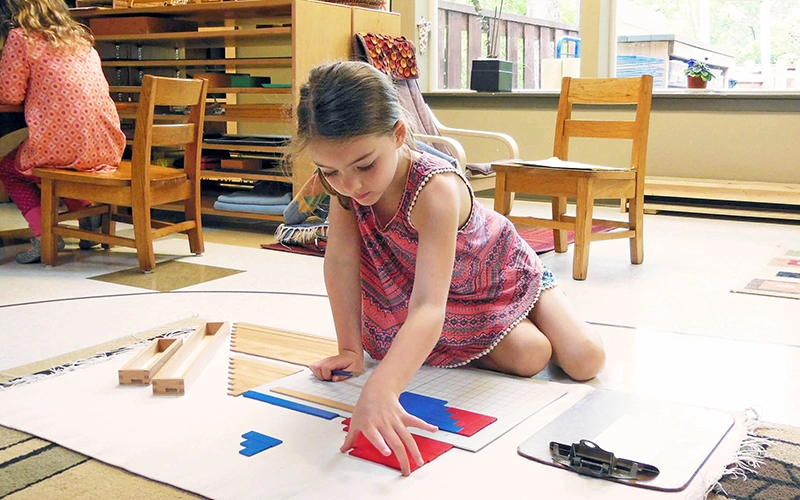
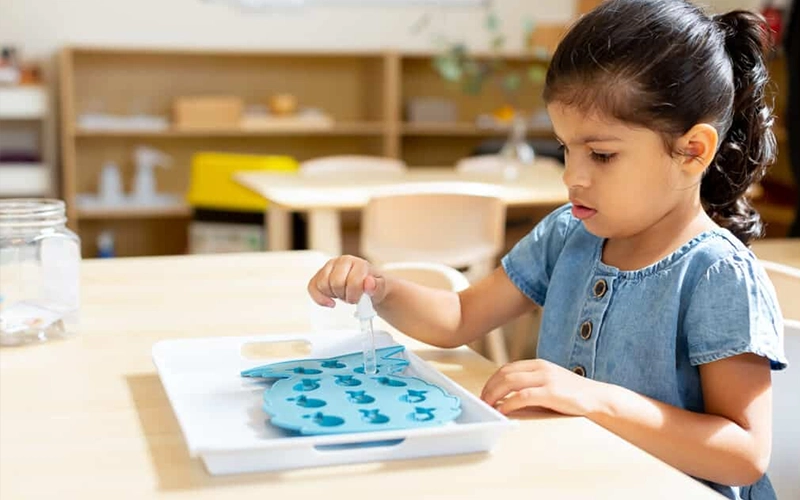
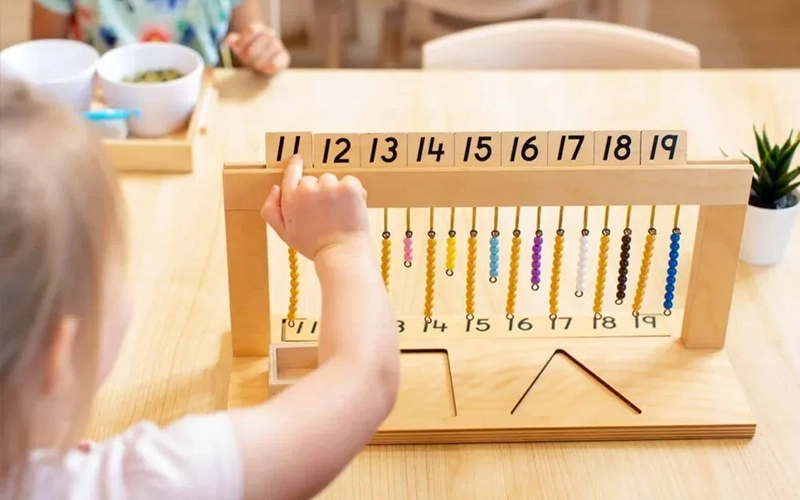
How to Apply Montessori at Home
Transforming your home into a mini-Montessori environment doesn’t require a full classroom—it just needs intention, structure, and thoughtfully selected tools. These steps will help you implement Montessori principles in a way that promotes independence, poise, and natural learning in a family setting.
1. Plan Your Montessori Home Environment
Even in small spaces, the layout matters. Identify three core zones:
- Self-care Zone – A low shelf for clothing, a child-sized stool for brushing teeth, and mirrors at eye level.
- Practical Life Zone – A tray with authentic dishes, fabric folding basics, and brushing/cleaning materials.
- Learning Zone – A small table or floor mats for sensorial, literary, and numerical activities.
Tips for Compact Homes:
- Use rotating baskets instead of fixed shelves.
- Repurpose furniture—lowering a coffee table or adding child-focused access bars on cabinets.
- Combine zones where needed to avoid cluttered transitions.
2. Choose Materials Slowly and Intentionally
Montessori at home means quality over quantity. Begin with three or four well-made, purposeful materials aligned with your child’s developmental phase, then expand thoughtfully.
Suggested Starter Sets:
- Real Utensil Tray: Knife, fork, salt shaker—supports mealtime independence.
- Small Sensorial Kit: Color tablets or textured objects for sorting.
- Moveable Alphabet: Cards for phonics and early writing.
Keep materials on a low shelf, in order. As your child demonstrates readiness, rotate materials or integrate new ones following a “small steps” approach to avoid overwhelm.
3. Structure a Simple Rhythm, Not a Full Schedule
Avoid rigid routines. Instead, implement a morning rhythm like this:
- Breakfast → Self-care
- “Work Time” (30–60 minutes)
- Reflect together (e.g., journal, story sharing)
- Outdoor or unstructured creative time
The goal is flow—building periods of independence without overwhelming structure.
4. Model Peaceful Engagement and Respect
In Montessori, adults model behavior more than they instruct. Sit quietly with your child during “work time,” demonstrating focus and calm—the ultimate invitation to independence.
Avoid praise-heavy or directive language. Instead, narrate neutrally:
“I see you’re placing colors in order.”
This approach fosters a sense of agency rather than judgment.
5. Observe, Reflect, and Adapt
Observation drives the Montessori approach—AND your parenting. Don’t interrupt focus, but take notes on:
- What objects attract your child?
- How do they handle frustration or success?
- Do they repeat specific tasks more often?
These cues guide future material selection and environmental tweaks.
Bringing Montessori into the Home, Step by Step
Transitioning your home into a mini-Montessori environment can look like:
✓ Week 4 and beyond: Observe, adapt, cycle materials, and maintain order.
✓ Week 1: Introduce the Self-care Zone.
✓ Week 2: Add Practical Life trays and invite independent use.
✓ Week 3: Rotate in a Sensorial or Literacy activity based on your child’s interests.
Advantages & Disadvantages: A Balanced Look with Solutions
While the Montessori Method offers transformative benefits, no educational approach is without challenges. Here, we present a nuanced assessment—highlighting both strengths and areas needing attention—while providing clear solutions and product support to bridge any gaps.
Advantages of the Montessori Method
- Promotes Deep Concentration
Children engage in uninterrupted work cycles, fostering deep focus far beyond what’s typical in conventional classrooms. - Encourages Independence and Responsibility
Access to child-sized furniture and fundamental tools empowers children to make choices, carry tasks through to completion, and care for their environment. - Supports Individualized Learning
The method thrives on observing and responding to each child’s readiness and interests, unlike age-based curricula. - Fosters Social and Emotional Intelligence
Mixed-age groupings promote peer teaching, collaboration, and empathy. - Cultivates Lifelong Love of Learning
Intrinsic motivation—encouraged by autonomy and mastery—builds a self-directed path that lasts well beyond early years.
Disadvantages & How to Address Them
| Challenge | Solution Strategy | Product/Application |
|---|---|---|
| Perceived lack of structure for parents and teachers | Educator orientation sessions and visual schedules at home and in school | Lesson planning kits; magnetic schedule boards; parent guides |
| Implementation costs of high-quality materials | Phased purchasing plans and certified second-hand materials | Budget starter packs; tiered classroom kits; trade-in options for used sets |
| Risk of inconsistency without proper training | Ongoing coach visits, peer observations, and in-service workshops | Training subscriptions; observation logs; video-based mentor sessions |
| Child loses focus during transition phases | Defined transition strategies and transition “stations” | Transition mats; choice boards; time trackers |
| Difficulty adapting in traditional school transitions | Hybrid models, narrative assessments, and cross-method preparatory phases | Portfolio kits; dual-function materials adaptable to both academic and Montessori environments |
Turning Disadvantages into Strengths
Our solutions—explicitly developed for Montessori environments—make these challenges manageable and even beneficial over time. For example:
- Visible tools and schedules provide reassurance and clarity without imposing rigidity.
- Phased material implementation allows schools to build authentic environments gradually.
- Certified training and resources ensure fidelity to the method and maintain quality across educators.
These solutions empower administrators and parents to confidently support Montessori learning, even in resource-constrained or hybrid settings.
Why This Balanced Perspective Matters
This section isn’t just academic transparency—it’s strategic positioning. Presenting both pros and cons, along with practical solutions, shows that you:
- Understand real-world constraints
- Provide tangible value—not every product, but the right tools
- Offer a tested, phased path to implementation
- We are committed to Montessori authenticity and long-term success
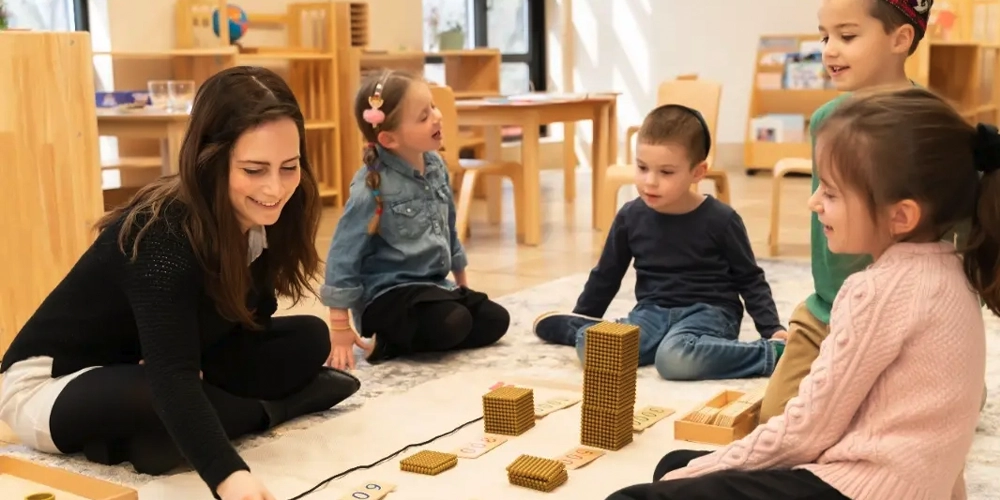
Conclusion
The Montessori Method is more than an educational approach—it’s a philosophy of human development. It honors the child’s autonomy, natural curiosity, and inner need for order, purpose, and joy. Unlike traditional systems that impose learning, Montessori invites it through careful design, respectful adult roles, and thoughtfully crafted materials.
From prepared environments to sensorial tools, from inclusive practices for neurodivergent children to practical applications at home, Montessori is both timeless and timely.
For educators, administrators, and parents, adopting this method means not just embracing a teaching style but shifting your view of what learning really is.
This article is part of our educational theory series exploring influential thinkers who reshaped how we teach and learn.
- Learn how Jean Piaget’s cognitive development theory aligns with Montessori’s self-directed approach.
- Discover Lev Vygotsky’s sociocultural theory and how the zone of proximal development intersects with Montessori’s sensitive period framework.
Together, these perspectives help you understand not just what works in Montessori but why it works.
FAQs
1. Why do Montessori classrooms span a three-year age range?
Montessori classes typically group children across a three-year age span (e.g., 3–6 years old). This enables younger children to learn by observing older peers, while older children deepen their understanding by mentoring others. Such multi-age dynamics foster leadership, empathy, and collaborative learning.
2. How is discipline managed in Montessori settings?
Discipline in Montessori doesn’t rely on rewards or punishments. Instead, children are guided to self-regulation through clear expectations, respect for materials, and understanding natural consequences. Teachers intervene only when a child’s actions disrupt the environment or harm others.
3. How many students are in a Montessori classroom?
Rather than aiming for minimal class sizes, Montessori classrooms prioritize optimal teacher-to-student ratios—typically one guide plus an assistant for 25–30 students. While this may seem significant, the mixed-age, self-directed environment fosters strong social dynamics and real-world community interaction.
4. Does Montessori education only cater to the privileged?
Montessori originated with underserved children, not the elite. While early adoption in private schools created that perception, the method has grown globally, including in public and low-income settings. According to AMS and global usage statistics, it now serves a diverse demographic and prioritizes accessibility over exclusivity.
5. Is it true that Montessori classrooms have “no rules”?
No. Montessori classrooms operate on the principle of freedom within limits. Children are free to choose their work, but only after lessons on how to use materials respectfully. The classroom environment—and the teacher’s role—ensures children understand boundaries and respect for themselves, others, and materials.
